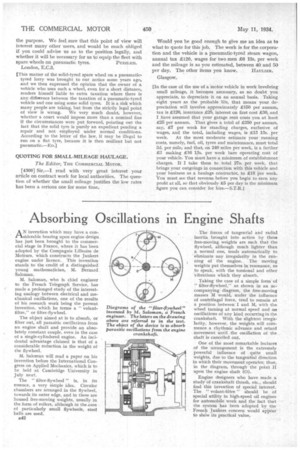Absorbing Oscillations in Engine Shafts
Page 60

If you've noticed an error in this article please click here to report it so we can fix it.
AN invention which may have a considerable bearing upon engine design has just been brought to the commercial stage in France, where it has been adopted by the Compagnie Lilleoise de Motburs, which constructs the Junkers engine under licence. This invention stands to the credit of a distinguished young mathematician, M. Bernard Saloman.
M. Saloman, who is chief engineer to the French Telegraph Service, has made a prolonged study of the interesting analogy between electrical and mechanical oscillations, one of the results of his research work being the present invention, which he terms a " volantfare," or filter-flywheel.
The object aimed at is to absorb, or filter out, all parasitic oscillations from an engine shaft and provide an absolutely constant couple, even in the case of a single-cylindered engine. An incidental advantage claimed is that of a considerable reduction in the weight of the flywheel.
M. Saloman will read a paper on his invention before the International Congress on Applied Mechanics, which is to be held at Cambridge University in July next.
The " filter-flywheel " is, in its essence, a very simple idea. Circular chambers are arranged in the flywheel, towards its outer edge, and in these are housed free-moving weights, usually in the formal rollers, although in the case of particularly small flywheels, steel balls are used.
B42
The forces of tangential and radial inertia brought into action by these free-moving weights are such that the flywheel, although much lighter than a normal one, tends automatically to eliminate any irregularity in the running of the engine. The moving weights put themselves in resonance, so to speak, with the torsional and other vibrations which they absorb.
Taking the case of a simple form of "filter-flywheel," as shown in an accompanying diagram, the free-moving masses M would, under the influence of centrifugal force, tend to remain at a position between I and M, with the wheel turning at normal speed and no oscillations of any kind occurring in the crankshaft. With the slightest irregularity, however, the weights will commence a rhythmic advance and retard movement until .the oscillation of the shaft is cancelled out.
One of the most remarkable features of the arrangement is the extremely powerful influence of quite small weights, due to the tangential direction in which their movement operates; thus, in the diagram, through the point H upon the engine shaft (0).
Engine designers who have made a study of crankshaft thrash, etc., should find this invention of special interest. The " volant-filtre " should be of special utility in high-speed oil engines for automobile work and the fact that the system has been adopted by the French Junkers concern would appear to show its practical value.




































































































